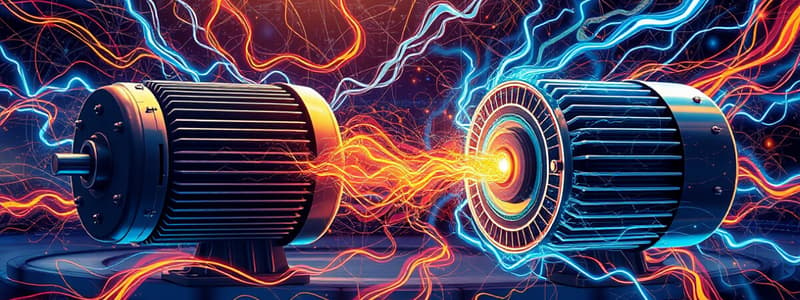Podcast
Questions and Answers
What happens to the rotor once current is supplied through the slip rings?
What happens to the rotor once current is supplied through the slip rings?
- It completely loses its magnetic properties.
- It generates a static magnetic field.
- It becomes a magnet with N-Pole and S-Pole. (correct)
- It stops moving until further power is supplied.
What is the result of the rotor's movement in relation to the static loops?
What is the result of the rotor's movement in relation to the static loops?
- The loops create a stronger magnetic field that repels the rotor.
- The movement causes the magnetic field to cut through the loops, inducing current. (correct)
- The static loops become electrified permanently.
- The movement prohibits any current flow in the loops.
After the alternator produces alternating current (AC), what happens next?
After the alternator produces alternating current (AC), what happens next?
- It directly powers the vehicle accessories.
- It is immediately stored in the battery.
- It is converted to direct current (DC) via a rectifier. (correct)
- It is transformed into a lower voltage AC before use.
What occurs when the ignition switch is turned on in the alternator system?
What occurs when the ignition switch is turned on in the alternator system?
What is the role of the alternator pulley in the overall operation?
What is the role of the alternator pulley in the overall operation?
Flashcards are hidden until you start studying
Study Notes
Current in Single Loop
- Conductor is arranged in loops within a casing to interact with a magnetic field.
- The rotor serves as the moving magnet.
- The configuration of the conductor loops and the rotor is complementary.
- When current is supplied to the rotor via slip rings, it creates a magnetic field with distinct N and S poles.
- As the rotor rotates, it causes the magnetic field to intersect with the loops of the conductor.
- This interaction induces current in the stationary loops, generating alternating current (AC) due to the regular alteration of magnetic pole direction.
- The direction of the induced current reverses every cycle, characteristic of AC.
Alternator Action
- Activation occurs when the ignition switch is turned on, sending current to the slip rings from the field terminal, thereby magnetizing the rotor.
- Cranking the engine initiates movement through the alternator pulley, which connects to the alternator shaft.
- The rotation of the alternator shaft causes the rotor to turn.
- This rotation results in a moving magnetic field that induces current in the stator winding.
- The alternating current generated is then transmitted through the field terminal to the alternator.
- The AC current first passes through a rectifier to convert it to direct current (DC).
- The DC power is supplied to the vehicle battery and its accessories, facilitating their operation.
Studying That Suits You
Use AI to generate personalized quizzes and flashcards to suit your learning preferences.




